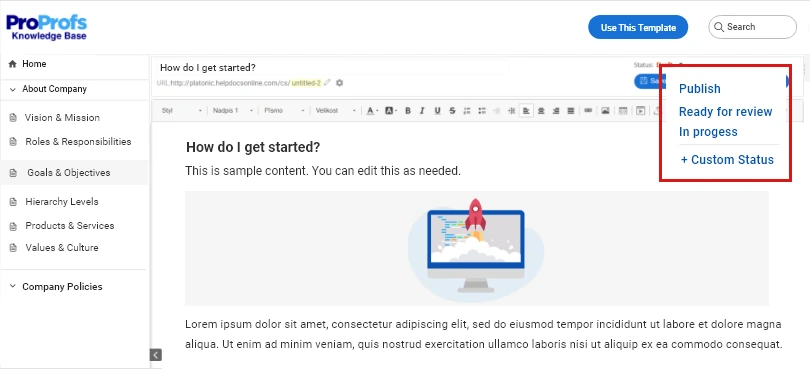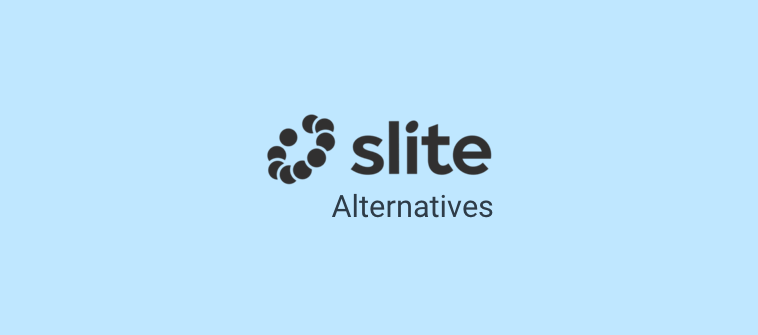
There are scores of software products on the market, but only a few manage to win customers.
Why is that so?
That’s because while most products focus on offering the best-in-class features, only a few provide customers with what they really want – a convenient, hassle-free experience.
Something as simple as technical documentation can make customers’ journey with your product a lot more smooth and effortless.
Technical documentation is a comprehensive document with step-by-step instructions on how to make the most of your product and overcome roadblocks to achieve optimum results.
It demonstrates your product’s features and functionality through how-to videos and visual guides to help customers understand how your product works and address challenges on their own.
Read this blog to unleash the potential of technical documentation and uncover 6 simple steps to build a stunning document for your product.
Let’s go!
What Is Technical Documentation?
Technical documentation is a one-stop point where your customers can find helpful information about your software product.
It comprises detailed articles on your product’s architecture, features, functionality, installation, and setup process. Customers also get access to how-to videos, troubleshooting guides, and training materials that help them get adept with your product and solve problems instantly.
This documentation has a powerful search bar that serves up accurate information closely matching customers’ queries. The articles are well-structured with relevant internal linking to ensure customers get all that they need in just a few clicks.
Types of Technical Documentation
There are different types of technical documentation you can create for your customers. Let’s look at some of the most common ones.
Product Documentation
Product documentation revolves around the features, functionality, and use cases of your software product. Its main purpose is to help end-users make the most of your software and achieve the intended results with minimal hassles.
It guides customers through step-by-step instructions and how-to videos, helping them put your product to maximum use and solve problems independently.
Process Documentation
Process documentation is all about the processes that go into the development, launch, testing, and maintenance of your software product. It showcases all the events and steps that formed a vital part of your product development journey.
This document is designed for internal use by-product and development teams to help them keep a close eye on the different stages your product went through during its lifecycle.
Read More: 15 Best Software Documentation Tools for 2023
User Guides or Manuals
User manuals and guides are best for onboarding customers to your product. It takes new users through all necessary features and explains troubleshooting steps through video demonstrations. Moreover, these guides can be embedded in your in-app help widget to provide new users with on-the-spot help right inside your product.
Read More: 11 Best Online User Manual Tools for 2023
Why Is Technical Documentation Crucial for Your Business?
Creating technical documentation is the best thing you can do for your business.
While it offers multiple benefits, the most vital one is that it equips customers with up-to-date information about a product. This simple advantage leads to several other benefits, such as:
1. Keeps Your Support Tickets Down
Every time customers run into technical issues, they can simply refer to your documentation for quick fixes. As customers become independent problem solvers, the volume of tickets reaching your help desk reduces significantly.
This relieves your support team from answering recurring questions, and they can utilize their time and effort in solving high-impact problems.
Read More: How to Reduce Support Tickets With Self-Service Knowledge Base
2. Delivers 24×7 Contextual Help
Technical software documentation helps you deliver contextual help to customers right when they need it. You can embed technical documentation in the in-app help widget and provide customers with instant access to contextual help right inside the product.
This is a great way to help them overcome challenges on the spot right when customers encounter them.
Contextual assistance inside the product improves the overall usability and enables customers to achieve success faster.
Read More: 10 Best IT Documentation Software & Tools
3. Make Informed Decisions
Accessing product information is a breeze with technical documentation. Your product team, developers, as well as customers can gain quick access to critical data and insights, which helps them make informed decisions. Even if they go wrong with a feature, they can quickly look back at your documentation and take corrective actions.
Read More: Best Technical Writing Tools For 2023
How to Create Technical Documentation in 6 Simple Steps
Now that the basics of technical documentation are clear, let’s move on to the next chapter, which focuses on how you can create one such document for your business.
Here are 6 simple steps that will get you started in the right direction.
1. Conduct Research to Identify the Topics to be Added
Writing technical documentation can seem like an added burden initially. However, once you start reaping the benefits, you will realize that it was worth the effort.
Like every process, creating documentation also requires solid research.
As part of the research process, you can consult with subject matter experts and key members of your product, development, and sales teams to identify topics that should be added to your documentation.
Ask them about the pain points customers are most frustrated with and the challenges they frequently encounter.
This will help you identify high-impact topics that should be covered in your technical document. Once you have a list of topics to be added, build a plan to guide your team’s efforts and set deadlines for the entire project.
Besides research, you also need to get your objectives clear in this stage.
Ask yourself:
- What goals do you want to achieve with this documentation?
- What product areas do you want to cover?
- What format do you want for your documentation?
Find answers to these questions and get on with the next step that’s all about collaborative content creation.
2. Author Content Collaboratively
Once you are done with the research part, the next step is to build content for your technical documentation.
Authoring content is an arduous task requiring lots of time and effort, and therefore, you need not one or two persons but an entire team to work together on this task.
Identify the most appropriate employees who qualify for this role and bring them under one roof. Look at the track record of your key employees to spot the ones who can add value to the documentation process.
These people can be product developers, technical writers, and project managers, who bring their unique skills to the table, and ensure your documentation gets off the ground quickly.
Once you have your team ready, let them work in collaboration and take charge of separate tasks, such as writing, editing, and document management, depending on their specific skills.
Such a collaborative workspace where key knowledge holders come together and bring their business-critical insights to the table ensures that the best content goes into your documentation.
Here’s a quick video on teams can work collaboratively to produce a flawless technical document.
3. Design Your Documentation
Large, running blocks of text can make the learning experience quite overwhelming for customers. They are bound to get lost in the information and fail to make sense of anything at all.
Design and structure are two vital elements that should be incorporated into your documentation. How your document appears on the outside to customers is equally important as the content it includes inside.
When designing your documentation, there are a few things you should keep in mind.
First, use your brand name and logo and set up a custom domain for your technical document. Incorporate colors, themes, designs, and fonts that reflect your company’s branding.
Talking about structure, your documentation should be neatly organized with a table of contents on the left, a search bar at the top, and topics segregated into relevant categories and subcategories.
Doing these simple things right will help customers jump from one topic to another effortlessly without browsing through each and every page.
Modern technical documentation tools offer ready-made templates, using which you can give a consistent and visually-appealing design to your documentation without much effort.
These templates do most of the heavy lifting when it comes to the design and structure of the documentation, so you can stay laser-focused on building quality content.
Watch this video to learn more about designing your documentation.
4. Review Rigorously to Achieve Error-Free Documentation
Technical documentation is served to your customers, so they can make the most of your product and solve problems in a heartbeat.
It is a crucial document that dictates your product’s success and failure, as well as your customers’ happiness or frustration.
Rigorous content review is, therefore, a vital part of the process that shouldn’t be brushed under the carpet, no matter how long it takes.
With fresh pairs of eyes looking at your documentation, you will have access to unique insights into gaps existing in the content and the effectiveness of articles. Also, this is the best way to ensure your content scores high on grammar, structure, and clarity.
Deploying the best technical documentation software will help you set up a dedicated review and approval system where every article can be given status for transparency.
Editors and subject matter experts can keep an eye on completed articles, so they can be reviewed and revised in time before going live.

5. Take Your Documentation Live
You are now ready to launch your documentation.
When publishing, ensure that the technical documentation can be accessed seamlessly across devices – mobile phones, laptops, as well as tablets, for a convenient self-service experience.
You can also give customers the option to download the document as a PDF or ebook for later use.
When publishing technical documentation, you might want to capture customer feedback on the helpfulness of the content. You can do that by adding feedback forms at the bottom of every article.
Such forms ask customers a direct question – Was this information helpful?, with two simple options – Yes and No, and a comment box to elaborate on the problem.
Additionally, you can also embed survey forms where customers can write about their issues and even raise a ticket to get quick resolutions.
Watch this video to learn more about adding feedback forms and surveys to your documentation.
Leverage Analytics to Improve Your Documentation
Technical documentation is dynamic in nature.
Based on the developments in your product, the document demands regular updates and improvements.
Content may get stale after a point as customer needs and preferences change, which means you will have to continuously identify opportunities to replenish your documentation with new information.
So, you are never really done with writing content for technical documents.
Modern documentation tools come with built-in reports that give rich insights into several performance metrics, such as failed searches, poor-performing articles, and broken links. Harness the power of analytics to gauge and boost article performance.
Such analysis can be done weekly, monthly, or yearly based on how frequently your products undergo changes and how eager you are to keep your content up to date. The best way out here is to set a maintenance schedule to ensure your documentation is refreshed regularly at all costs.
Watch this quick video on how reports can be analyzed to elevate your documentation’s performance.
Do’s & Don’ts of Creating Technical Documentation
Before you start writing technical documents, keep this list of do’s and don’ts in mind to ensure the final output is nothing but exceptional.
Do’s:
- Gain complete clarity on your target audience and create content specific to their needs and interests.
- Keep your writing simple and straightforward. Avoid complicated terms as much as possible.
- Use visual imagery to demonstrate your product’s features and functionality.
- Add feedback forms to your documentation to capture valuable feedback from end users.
- Publish your documentation across the web and mobile devices for ease of access
Don’ts:
- Use passive voice in your articles.
- Add large, running paragraphs as they can be a turn-off for readers
- Use jargon as they can be confusing for customers
- Assume your audience knows the topic in and out
Get Your Documentation Off to a Great Start
How to create technical software documentation is a question most businesses struggle to find the answer to.
It’s not as difficult as it seems. All it requires is clarity of thought and straightforward goals to get started. Consider half of your job done when you know what you wish to accomplish with your technical documentation.
The other half is all about implementing the right steps. For example, conducting rigorous research to uncover the topics to add to your documentation is what sets the tone for the rest of the process.
After the research part comes writing, where you need to bring subject matter experts on board to create content collaboratively. As articles are written, they should be reviewed thoroughly to ensure zero errors.
Finally, you can take your documentation live for customers to consume.
For successful implementation of this process, the support of a powerful documentation tool like ProProfs Knowledge Base can prove incredibly helpful. It is well-equipped with top-notch features that let you write, design, and publish content with unmatched ease.
Do you want a free Knowledge Base?
We have the #1 Online Knowledge Base Software for instant self-help






